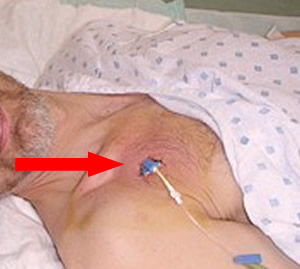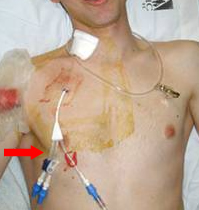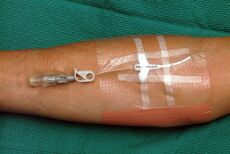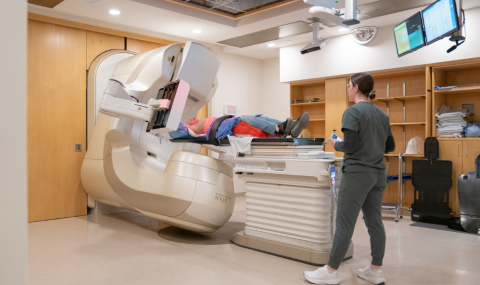|
CENTRAL VENOUS CATHETERS; CENTRAL LINE A "Central Venous Catheter" or Central IV is an intravenous catheter that is inserted into a large vein close to the right side of the heart. These catheters are inserted percutaneously ("cutaneous" means skin, "per" means through). The most common sites are: subclavian (upper chest), jugular (neck) or femoral (groin) [Image 1]. Many of the drugs used during critical illness are irritating or harmful to small blood vessels. Administration of these drugs into large central veins allows the drugs to be rapidly diluted by the large blood volume. Drugs that are used to treat low blood pressure, chemotherapy agents and solutions with high concentrations of glucose (sugar) are examples of drugs that need to be administered through a Central Vein. Most critically ill patients will have a Central Venous Catheter. Central Venous Catheters can be used for other reasons. They can be connected to a pressure monitoring system and used to measure the pressure inside the right side of the heart. This pressure is known as the Central Venous Pressure or CVP. CVP measurements help us to determine the amount of IV fluid a patient needs. A large Central Venous Catheter makes it easy to give fluid rapidly when required. Central venous catheters can also be used to measure the amount of oxygen in the blood that is returning to the heart. This is known as a venous blood gas sample. A low oxygen level in the venous blood indicates that the patient's cardiac output is too low. Many of the Central Venous Catheters used are "multi-lumen catheters". A multi-lumen catheter is a single catheter with more than one internal channel (called a lumen). A different intravenous infusion can be connected to each lumen, and the fluid will usually exit at a slightly different point along the catheter. A double lumen catheter has 2 lumens while a triple lumen catheter has 3. Multi-lumen catheters allow us to run several different infusion with only one access site (Image 2). Multi-lumen catheters are often inserted through a short central line with a wider inner diameter. This "introducer" can be used as an additional central line regardless of whether a catheter is inserted through the centre. The introducer is often called the "Cordis"; this was the Trade name for the first product ever produced. Another type of Central Venous Catheter is a PICC line. A PICC line is an IV that is inserted peripherally, usually in the bend of the arm. The catheter is very long and thin, and is advanced until the tip of the catheter is located in a large central vein. Thus, the catheter is called a Peripherally Inserted Central Catheter. PICC catheters can be used to give drugs that require a central line. They are generally not used for CVP monitoring. They take longer to insert than other central lines and are not generally inserted when the patient is acutely ill. They are most often inserted into longer stay patients if it becomes difficult to find a suitable IV site. Patients are transported to the radiology department for PICC line insertion. |
Image 1: Central venous line in subclavian site. |
|
Image 2: Multilumen catheter. |
|
|
Image 3: PICC Line. |
|
|
|
|
Last Updated: October 23, 2014
|
|
Our masking guidelines have been updated. Visit the Patient and Visitor Masking Guidelines page for more information.






